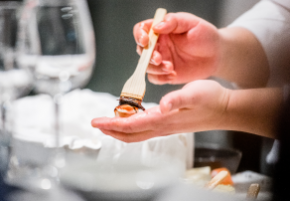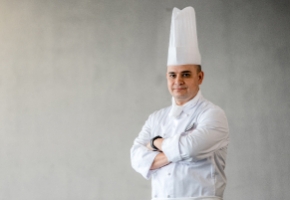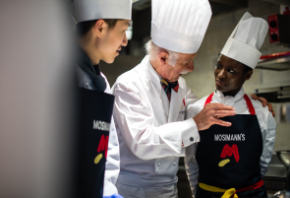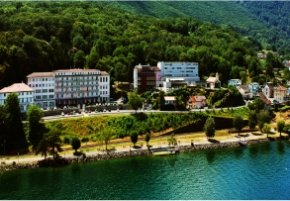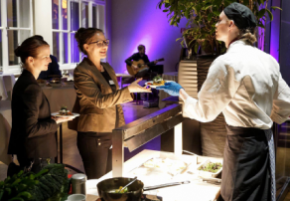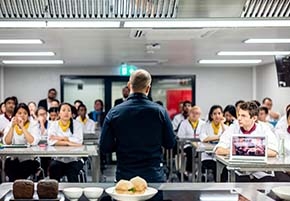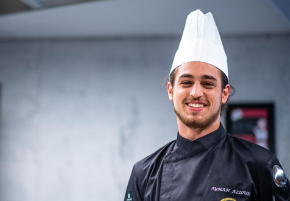- About
- Programs
- Campus Life
- Career Services
- Admissions
- News & Events
- Alumni
Sous Vide Mastery: Equipment, Temperature & Cooking Tips
Discover how to cook restaurant-quality meals with sous vide! Find the best equipment, time and temp charts, and expert techniques to make every meal perfect.
Key Takeaways
- Sous vide cooking ensures that food is evenly cooked by sealing it in a vacuum-sealed bag and placing it in a temperature-controlled water bath.
- Tools needed for sous vide cooking include a precision cooker to regulate temperature, vacuum sealers for sealing, and skillets or torches to improve texture.
- Sous vide works wonders for meats, vegetables, and even eggs and offers accurate temperature control for various textures.
Do you ever wish you could achieve the perfectly cooked steak, tender chicken, or juicy vegetables every time you make it? That is what sous vide cooking is all about. This method includes sealing food in a bag and placing it in a precisely heated water bath for it to cook evenly.
Sous vide was initially developed in France in the 1970s by chefs and scientists. Ever since then, it has transformed into a favorite technique even among home cooks, offering high-quality results with minimal effort.
What Is Sous Vide?
Sous vide is an accurate cooking technique where vacuum-sealed food is gently cooked in a controlled-temperature water bath. Sous vide doesn’t rely on direct heat like traditional methods; it cooks evenly from the edge to the center and prevents overcooking. A sous vide machine maintains a constant water temperature, allowing food to reach its perfect texture without drying out.
Sous vide has become increasingly accessible to home cooks with affordable machines and a growing interest in accurate cooking. It offers amazing consistency and improved flavor, whether for meats, vegetables, or desserts.
Essential Sous Vide Equipment
Achieving perfect results with sous vide cooking starts with the right tools. Although some tools are a must, others can be substituted depending on the setup. Understanding these tools ensures an efficient sous vide experience.
Sous vide precision cookers
Sous vide precision cookers, also known as immersion circulators, ensure a consistent water temperature, preventing overcooking. These tools heat and circulate water and keep it at an accurate temperature for consistent results.
When choosing a precision cooker, consider factors such as temperature accuracy, wattage for quick heating, Wi-Fi or Bluetooth connectivity for remote control, and ease of use to meet your cooking needs.
Vacuum sealers and alternative methods
Vacuum sealers are essential for sous vide cooking, as they remove air from the bag and prevent water from entering. A reliable vacuum seal helps retain flavor, moisture, and nutrients. When selecting a vacuum sealer, consider factors such as strong suction power, durability, ease of use, and compatibility with different bag types.
For budget-friendly options, handheld vacuum sealers and manual pump sealers work well for everyday use. Premium models, like chamber vacuum sealers, offer a stronger seal and can handle liquids, making them perfect for frequent sous vide cooking.
If a vacuum sealer is unavailable, alternative methods like the water displacement technique can be used. This includes slowly putting a zip-top bag with food into the water to push out the air before sealing it completely. Although it’s not as airtight as a vacuum sealer, it’s a practical and accessible method for home cooks.
Water containers and racks
A well-insulated water container helps maintain a stable temperature during sous vide cooking by reducing heat loss and minimizing energy consumption. Standard options involve polycarbonate containers and stockpots. While polycarbonate containers are lightweight, durable, and heat-resistant, stockpots are budget-friendly for many home cooks.
Racks can keep food bags fully immersed and evenly spaced to prevent them from floating or overlapping. Although not always necessary, racks can be helpful for larger batches or longer cooking times.
Finishing tools
Searing is an important step after sous vide cooking, creating a flavorful and crispy crust that improves texture. Since sous vide cooks food at an accurate and lower temperature, proteins like steak, chicken, or fish may look pale or lack the caramelization that high-heat cooking provides.
The best tools for searing involve cast iron skillets, which maintain high heat for an even crust, and kitchen torches, which offer precise browning for delicate foods. Broilers and grills can be great options, adding grill marks for a final touch.
In addition to searing, finishing touches like butter, herbs, and sauces can elevate the flavors. A quick baste with garlic butter, a sprinkle of flaky salt, or a drizzle of a rich sauce can improve the final dish and make it even more delicious.
Sous Vide Time and Temperature Chart
Understanding the time and temperature needed for sous vide cooking is essential for achieving perfectly cooked food. Accurate control allows consistent results and ensures proteins are tender while vegetables retain their nutritional value.
Below you’ll find the best temperatures for common proteins and the recommended time and temperature for vegetables and eggs in sous vide cooking.
Best temperatures for common proteins
The perfect texture in proteins is key to improving flavor and taste. Sous vide cooking offers accurate control of temperature to achieve the best results.
Different temperatures affect the texture of proteins. For example, a medium-rare steak at 54°C to 57°C will be tender and juicy, while a well-done steak cooked above 63°C becomes drier. At the same time, cooking chicken at lower temperatures, like 60°C, can create a moist and tender texture, whereas higher temperatures may be safer but also have drier results.
Here are the ideal temperatures for common meats:
- Steak:
- Medium-rare: 54°C to 57°C for 1 to 4 hours.
- Medium: 57°C to 62°C for 1 to 4 hours.
- Well done: 63°C to 71°C for 1 to 4 hours.
- Chicken:
- Tender and juicy: 60°C to 74°C for 1 to 4 hours.
- Lamb:
- Medium-rare: 54°C to 57°C for 1 to 4 hours.
- Medium: 60°C to 65°C for 1 to 4 hours.
- Fish:
- Tender and flaky: 52°C to 60°C for 30 minutes to 1 hour.
Vegetables and eggs in sous vide
Sous vide cooking is not only for meats; it is perfect for preparing vegetables and eggs, creating ideal flavors and textures. This method ensures that even cooking is done without turning them mushy or overdone. Here are the best temperatures and times for some popular vegetables:
- Carrots: 84°C for 1 hour to 1.5 hours—tender and slightly crispy.
- Asparagus: 82°C for 10 to 15 minutes—bright and firm.
- Potatoes: 90°C for 1 to 2 hours—soft and creamy.
Eggs are the ideal ingredients for sous vide cooking since even a slight temperature change can create different textures. Whether you like runny yolks, silky whites, or a custard-like consistency, sous vide allows you to control the final result.
- Soft-boiled egg: 75°C for 13 minutes to create silky whites and a runny yolk.
- Poached-style egg: 63°C for 45 minutes to have delicate whites and a creamy yolk.
- Custardy yolks: 65°C for 45 minutes to have soft and thickened yolks.
How to Sous Vide: Step-By-Step Guide
Sous vide yields delicious results with minimal effort. Follow these steps to get started:
- Prep the ingredients: Start by choosing and preparing your ingredients. Clean and cut vegetables, then season proteins with herbs, spices, or marinades to achieve a balance of flavors.
- Seal the bag: Place the prepared ingredients in a vacuum-sealed container or a zip-top bag. If you’re using a vacuum sealer, remove as much air as possible. For zip-top bags, use the water displacement method to push out the air before sealing.
- Set up the water bath: Fill a container with water and attach your sous vide precision cooker. Set the preferred temperature based on the food you’re cooking.
- Cook: Place the sealed bags in the water bath and make sure they’re fully submerged and aren’t touching the sides of the container. Cook for the recommended time based on the type of food you’re preparing.
- Finish the dish: Once cooking is done, remove the bags from the water bath. For proteins, sear them in a hot skillet or use a kitchen torch for a crispy exterior. Consider adding a finishing touch through seasoning or a quick sauté for vegetables.
- Serve and store: Plate your dish and serve immediately for the best taste. If you’re not serving right away, store the sealed bags in the refrigerator for up to a week or freeze them for more extended storage. When ready to eat, reheat in the water bath to retain the preferred temperature and texture.
Advanced sous vide techniques and pro tips
Advanced sous vide techniques allow chefs to create meals based on personal preferences and create high-quality dishes at home. As part of the Culinary Arts Academy Switzerland (CAAS) Distinguished Chef Series, students have the chance to learn from world-class, reputable chefs as they share their life stories, adventures, cooking tips, and methods.
Methods that can improve flavor, texture, and overall presentation include:
- Using ice baths: After cooking, quickly chilling food in an ice bath helps stop the cooking process to preserve and improve the preferred cooking texture. This is especially useful for meal prep or when you’re cooking in advance.
- Multi-stage cooking: This technique involves cooking food at different temperatures for different stages. For example, you can start by cooking a protein at a lower temperature to make it more tender and then increase the heat for a finishing touch.
- Infusing flavors: Sous vide is perfect for infusing flavors into foods. You can improve the taste of proteins and vegetables by adding herbs, spices, or aromatics to the bag.
- Batch cooking: Cooking in batches allows for efficient meal preparation. You can sous vide numerous portions at once, easily preparing meals for the whole week.
- Reverse searing vs. traditional searing: Reverse searing includes cooking the protein sous vide first, then finishing with a quick sear in a hot pan. This method allows the meat to cook evenly and create a perfect crust without overcooking the inner part. On the other hand, traditional searing cooks the outer part first, which may result in uneven textures and cooking. Reverse searing can help you control the final texture and appearance of the dish.
Benefits of Sous Vide Cooking
Sous vide cooking offers numerous advantages that elevate both the process and the results. From improving flavors to providing convenience, this technique ensures better control, consistency, and quality in the kitchen.
Below are some key benefits that make sous vide a preferred method for both home cooks and professionals:
- Improved flavor and juiciness: Cooking food in a sealed container allows it to maintain its natural juices and flavors for tender dishes.
- Convenience and meal prep: Sous vide cooking allows easy meal preparation since food can be cooked in advance and stored for later use. This technique is beneficial for batch cooking and will enable you to prepare multiple meals simultaneously. Reheating the meals is as simple as placing the sealed bags back in the water bath.
- Healthier cooking: Sous vide requires little to no added fats or oils, which makes it a healthier cooking method. The sealed environment helps preserve nutritional value and vitamins that make meals more delicious.
- Reduced food waste: Since sous vide cooking allows you to control cooking times, there is less risk of overcooking or burning food, which leads to waste. Vacuum-sealing food can lengthen its shelf life and minimize spoiling.
Elevate Your Cooking with Sous Vide
Sous vide cooking has become a transforming technique that improves flavor, tenderness, and overall quality for a variety of dishes. Understanding critical steps, like prepping ingredients, sealing bags, or cooking dishes, can help you achieve high-quality food at home. Advanced techniques like multi-stage cooking, ice baths, and flavor infusion allow you to customize your culinary experience even further.
Experimenting with different sous vide techniques and recipes allows you to discover what best suits your tastes. Investing in high-quality tools such as precision cookers and vacuum sealers can further enhance your cooking experience, making the process efficient and enjoyable.
For those eager to take their skills to a professional level, CAAS provides expert mentorship and structured learning. Programs like the BA in Culinary Arts or the Swiss Diploma in Culinary Arts cover modern cooking techniques, including sous vide, while also integrating business management and service skills—necessary for running a successful culinary venture.
As plant-based cuisine continues to grow in popularity, mastering sous vide can be a game-changer in your career. The Certificate in Plant-Based Culinary Arts program at CAAS focuses on innovative plant-based dishes and essential culinary techniques, equipping you with the expertise to excel in this evolving field.
Start your culinary journey today and explore our programs to enter the world of professional cooking!
Frequently Asked Questions
Is sous-vide worth it?
Yes, sous-vide improves flavor, texture, and accuracy in cooking which makes it an excellent investment for consistent results.
What is a sous vide machine?
A sous vide machine is a tool that keeps water at a specific temperature to cook vacuum-sealed food evenly.
Can I use any container for sous vide?
You can use heat-safe containers like plastic or metal pots, although they must be deep enough to fully immerse the food in them.
Interested in studying at CAAS? Download our brochure to learn about our programs!
